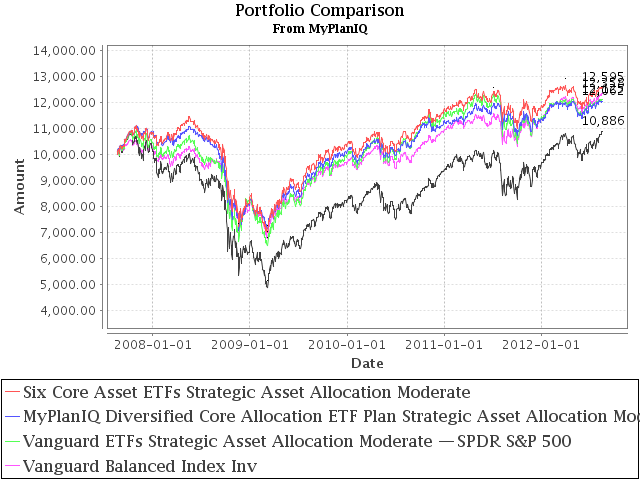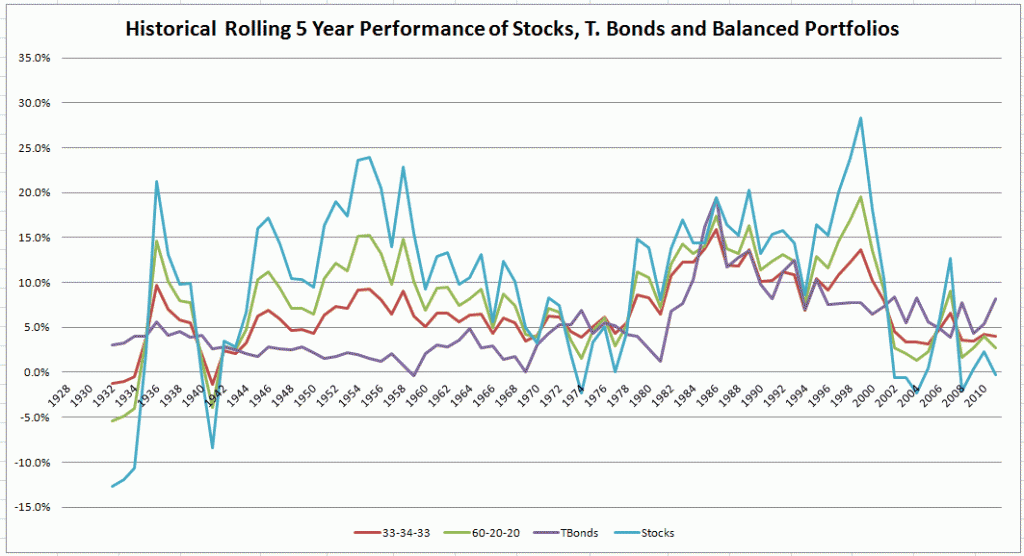Re-balance Cycle Reminder
Based on our monthly re-balance calendar, the next re-balance time will be on Monday, September 10, 2012. You can also find the re-balance calendar of 2012 on ‘My Portfolios’ page.
As a reminder to expert users: advanced portfolios are still re-balanced based on their original re-balance schedules and they are not the same as those used in Strategic and Tactical Asset Allocation (SAA and TAA) portfolios of a plan.
Also please note that we now list the next re-balance date on every portfolio page.
Portfolio Diversification: The First Line Of Defense
We are in a world of constant changes: financial bubbles and crises, national & political unrests, global disasters and wars, etc. Furthermore, these events last from several months to years, not short time spans for a human life. To make matters worse, investors are in constant barrage of news, advises and noises.
For most investors, fortunately, your first line of defense is to construct a diversified portfolio. By diversification, we mean you invest in assets (or asset classes — a more academic term) that should have sound, intuitive and historical data backings to their positive average (expected) returns. We alluded this concept in our previous newsletter July 4th 2011: What Make Strategic Asset Allocation Work?
It is interesting to read a recent commentary by PIMCO’s Bill Gross that bashes equities. We might concur with Mr. Gross’s conclusion that equities will have trouble in the coming decade. However, we believe his reasoning is flawed as he uses GDP growth as the sole yard stick to justify his reasoning. We believe, as what was stated in our previous newsletter, the risk premium that enables entrepreneurs to take a risk for better returns plays an equally (or more) important role in supporting the argument that broad base equity or stock indices (such as S&P 500) derive above cash average returns in the long term.
A portfolio with diversified asset classes can sustain loss in severe crises much better those that are non diversified such as a full stock portfolio. Recent stock market strengths have made headlines like Total Returns of Stock Market Near All Time High. However, for a balanced or diversified portfolio, it has recovered from the 2008-2009 loss completely much earlier.
The following chart shows how diversified balanced portfolios have performed, compared with S&P 500 (SPY) total return:
From the above chart, one can see that all the diversified portfolios completely recouped their loss in late 2010, almost two years earlier than S&P 500 (SPY).
A more useful historical performance metric is the so called rolling 5 years (or rolling 3, 10 years) performance. The following chart shows how two diversified portfolios compared with stocks and 10 year Treasury Bonds (TBond) since 1928.
Data are from NYU’s professor Aswath Damodaran. 33-34-33 represents 33% stocks, 34% Treasury Bills (3 months, usually treated as cash) and 33% Treasury Bonds (1o years).
There are two periods that the balanced portfolios had negative rolling 5 year returns: both 33-34-33 and 60-20-20 portfolios had consecutive 3 years (1932, 1933, 1934) negative rolling 5 year returns in the great depression. Both had one (1941) negative rolling 5 year return in World War II. Even though it created discomfort that in the great depression, the balanced portfolios suffered from loss for a relatively long period of time, in the real return sense (i.e. return minus inflation or Consumer Price Index (CPI)), they were actually positive as CPI had following since 1927 till 1935. It then fell again in the early years (1938, 1939) of World War II.
For equity (stock) investors, the above chart illustrates double dip negative rolling 5 year returns from 2000 to now, a pattern similar (though less severe) to the Great Depression. No wonder the recent recession has been called The Great Recession.
Notice that if you add Gold to the balanced portfolio, it is the permanent portfolio. In our previous article Harry Browne’s Permanent Portfolio Long Term Performance, we showed the historical year by year performance since 1970. Unfortunately, before 1968, gold price had been fixed relative to the U.S. dollars and thus it is meaningless for such a portfolio going back from 1968. From 1970 to 2011 (42 years total), one can easily see that the portfolio only had 5 individual year loss and it should not have any negative rolling 5 year return either.
The lesson from the above is that a diversified portfolio can help one cushion from severe blows even though these portfolios can still suffer from meaningful loss in one or two years. As long as you stick to a well balanced and conservative portfolio and willing to weather through a few years of discomfort (without panic that can result in abandoning equities or investment portfolios all together), you will do fine.
This is even more true for a retirement plan account which presumably you might not need the money (for most people) for many years. However, if you need money within 5 years, you might want to consider to put aside some money in short term investments to cover that.
Market Overview
We maintained our cautious attitude to the recent stock market strength. Again, we have not seen any meaningful or substantial structural change in the U.S., European and emerging market economies. However, we will let markets sort this out and will try to take advantage over its irrational behavior if it is possible.
For the time being, from 360° Market Overview, Gold (GLD) is now ranked at the bottom in the major asset class trend rankings. This reflects markets’ transient guess for the upcoming Goldilocks economy, a period without central banks and/or governments intervention and low inflation? Nobody knows for sure. It is thus even more important to have diversified and/or hedge portfolios.
We again would like to stress for any new investor and new money, the best way to step into this kind of markets is through dollar cost average (DCA), i.e. invest and/or follow a model portfolio in several phases (such as 2 or 3 months) instead of the whole sum at one shot.
Portfolio Review
Even with recent long term Treasury bonds’ weakness and anemic gold performance, permanent portfolios have remained steady, though lagging behind others. The following compares several permanent portfolios:
Portfolio Performance Comparison (as of 8/20/2012)
| Portfolio/Fund Name | 1 Week Return* |
YTD Return** |
1Yr AR | 1Yr Sharpe | 3Yr AR | 3Yr Sharpe | 5Yr AR | 5Yr Sharpe |
|---|---|---|---|---|---|---|---|---|
| Permanent Global Portfolio ETF Plan Strategic Asset Allocation Moderate | 0.1% | 5.7% | 4.7% | 19.8% | 9.6% | 80.3% | 5.3% | 29.2% |
| PRPFX | 0.4% | 3.5% | -1.0% | -19.1% | 11.2% | 113.0% | 8.5% | 62.7% |
| VBINX | 0.5% | 9.4% | 18.2% | 117.8% | 11.3% | 107.8% | 4.3% | 25.3% |
| Permanent Income Portfolio | -0.8% | 5.0% | 10.2% | 220.9% | 11.1% | 213.8% | 7.1% | 96.6% |
| Harry Browne Permanent Portfolio | -0.2% | 4.8% | 5.1% | 72.8% | 11.7% | 179.3% | 8.9% | 104.6% |
*: NOT annualized
**YTD: Year to Date
See more detailed comparison >>
Latest Articles
- Gold Descends To The Bottom Among Major Assets
- Tried and True Money Advice from Warren Buffett
- Why Goldman Refuses To Raise Its S&P 1250 Year End Forecast
- The Rationale For Momentum
- Total Returns of Stock Market Near All Time High
- Earn more money! A simple way toward building wealth
- How Your 401k Really Grows: Savings
- The Truth About the “Impending” Recession
- Valuable Property: REITs
- Muni Forecast: Lots of Clouds
- The Power of Effective Diversification
- Doug Kass: Why the Market has Hit the High for the Year
- Stable Value Funds Serve Investors But Scare Plan Sponsors
- August 13, 2012: Effective Safe Harbor Cash And Short Term Investments
How can we improve this newsletter — we value your inputs –Thanks to those who have already contributed — we appreciate it.


